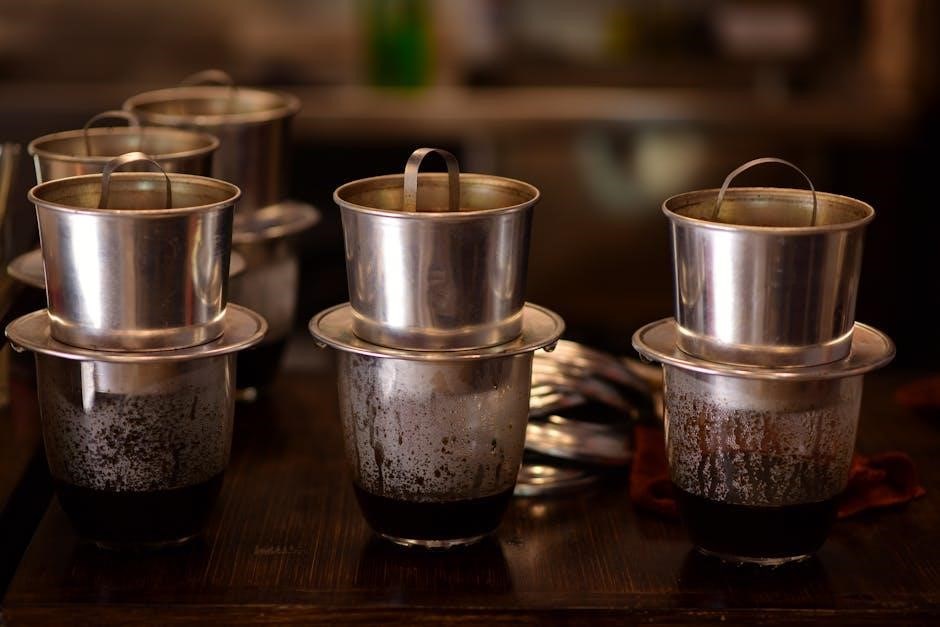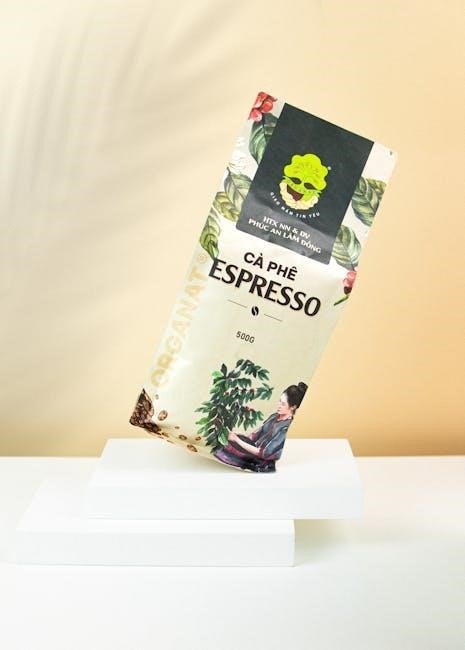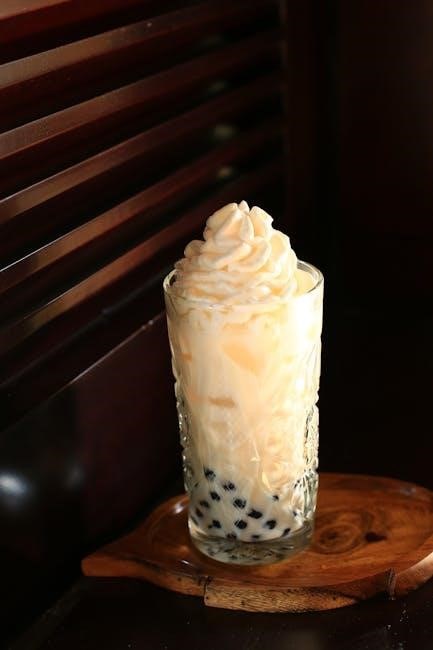Vietnamese coffee is a cultural symbol, known for its unique brewing methods and rich, bold flavors, with a vibrant coffee culture and a growing global following․
Overview of Vietnamese Coffee Culture
Vietnamese coffee culture is deeply rooted in tradition and social customs, with coffee serving as a symbol of hospitality and community․ Coffee shops, from sidewalk stalls to modern cafes, are vibrant social hubs where locals gather to chat and enjoy their daily brew․ The ritual of brewing coffee using the phin filter is a cherished tradition, emphasizing patience and mindfulness․ The culture blends French colonial influences with local flavors, creating a unique coffee experience that balances bitter and sweet notes․ Whether enjoyed hot or iced, Vietnamese coffee remains a cherished part of daily life and cultural identity․

History of Coffee in Vietnam
Coffee was introduced to Vietnam by French colonists in 1857, sparking a thriving agricultural industry and transforming the country into the world’s second-largest coffee exporter․
Coffee was first introduced to Vietnam by French colonists in the mid-19th century, specifically in 1857․ The French sought to establish coffee plantations to expand their colonial agricultural interests․ Over time, Vietnamese farmers adapted French techniques to local conditions, developing unique brewing methods and flavor profiles․ The use of condensed milk, due to limited access to fresh milk, became a defining feature of Vietnamese coffee․ This adaptation, combined with the country’s ideal climate for coffee production, led to the evolution of a distinct coffee culture that blends French influence with Vietnamese traditions․
Unique Characteristics of Vietnamese Coffee
Vietnamese coffee is renowned for its bold, rich flavor, often enhanced by sweetened condensed milk and traditional roasting techniques․ The use of a phin filter creates a distinctive slow-drip brewing process, resulting in a strong, velvety texture that sets it apart from other coffee styles․
Distinctive Brewing Methods and Flavor Profiles
Vietnamese coffee is brewed using a small metal phin filter, which allows for a slow drip, creating a thick, rich texture․ The coffee grounds are pressed firmly, and hot water is poured in a steady stream, resulting in a bold, intense flavor․ Sweetened condensed milk is often layered at the bottom, balancing the bitterness with its creamy sweetness․ This method produces a distinctive flavor profile, with notes of dark chocolate and caramel, making Vietnamese coffee uniquely robust and aromatic․ The combination of strong coffee and sweet milk creates a harmonious taste experience․
Traditional Roasting Techniques and Ingredient Blends
Vietnamese coffee is brewed using a small metal phin filter, which allows for a slow drip, creating a thick, rich texture․ The coffee grounds are pressed firmly, and hot water is poured in a steady stream, resulting in a bold, intense flavor․ Sweetened condensed milk is often layered at the bottom, balancing the bitterness with its creamy sweetness․ This method produces a distinctive flavor profile, with notes of dark chocolate and caramel, making Vietnamese coffee uniquely robust and aromatic․ The combination of strong coffee and sweet milk creates a harmonious taste experience․

Popular Types of Vietnamese Coffee
Vietnamese coffee offers diverse varieties, including Cà Phê Sữa Đá, Cà Phê Trứng, and Cà Phê Cốc, each showcasing unique flavors and cultural traditions, from sweet to rich and creamy․
Cà Phê Sữa Đá (Vietnamese Iced Coffee with Condensed Milk)
Cà Phê Sữa Đá is Vietnam’s iconic iced coffee, blending bold, dark-roasted coffee with sweetened condensed milk, served over ice․ Brewed using a phin filter, the coffee grounds are pressed, releasing a rich, intense flavor․ The condensed milk adds a creamy, sugary contrast, creating a velvety texture․ This refreshing drink is a staple in Vietnamese cafes and homes, symbolizing the country’s coffee culture․ Its simplicity and balance of flavors make it a beloved choice, perfect for hot days and casual gatherings, embodying Vietnam’s coffee heritage․
Cà Phê Trứng (Vietnamese Egg Coffee)
Cà Phê Trứng, or Vietnamese Egg Coffee, is a unique and creamy beverage originating from Hanoi․ Made with egg yolks, sweetened condensed milk, and strong coffee, it creates a velvety texture․ The egg yolks are whipped with milk until frothy, then layered over the coffee․ This rich drink tastes like a coffee-infused dessert, offering a sweet and savory experience․ Often enjoyed hot, it’s a must-try for coffee enthusiasts, showcasing Vietnam’s innovative approach to coffee․ Its origins date back to the 1940s, making it a cultural gem in Hanoi’s coffee scene․
Cà Phê Cốc (Vietnamese Black Coffee)
Cà Phê Cốc, or Vietnamese Black Coffee, is a staple in Vietnamese coffee culture․ Brewed using a phin filter, it results in a strong, dark coffee served in small portions․ The coffee grounds are pressed firmly, allowing hot water to slowly drip through, creating a concentrated brew․ Often enjoyed straight or with a touch of sugar, its bold, rich flavor is a favorite among locals․ This traditional coffee is a testament to Vietnam’s coffee heritage, offering a pure, unadulterated taste of its distinctive roast․

Best Places to Experience Vietnamese Coffee
Discover the vibrant cafes and cultural spots in Hanoi and Ho Chi Minh City, where traditional and modern coffee experiences thrive․
Famous Cafes in Hanoi and Ho Chi Minh City
Hanoi’s iconic Café Giang, nestled in the Old Quarter, is renowned for its egg coffee, a legacy since the 1940s․ Café Pho Co offers a serene rooftop view of Hoan Kiem Lake․ In Ho Chi Minh City, La Tamia stands out as a retro gem, blending old Saigon charm with vintage decor․ These cafes embody Vietnam’s rich coffee culture, serving traditional brews like cà phê sữa đá and innovative creations, attracting both locals and travelers seeking authentic experiences․

How to Make Vietnamese Coffee at Home
Use a phin filter to brew rich, dark roast coffee, mix with sweetened condensed milk, and pour over ice for an authentic cà phê sữa đá experience․
Step-by-Step Guide to Using a Phin Filter
Place the phin filter over a glass or cup, add 2-3 tablespoons of medium-coarse Vietnamese coffee grounds, and level them․ Gently press the filter to ensure even extraction․ Pour a small amount of hot water (around 200°F) to saturate the grounds, letting it bloom for 30 seconds․ Slowly add the remaining water, allowing the coffee to drip through the filter․ Once brewed, mix with sweetened condensed milk and pour over ice for a classic cà phê sữa đá․ Enjoy the bold, rich flavors of Vietnamese coffee at home․
Modern Trends in Vietnamese Coffee
Vietnamese coffee is embracing modern trends with innovative recipes and fusion drinks, blending traditional flavors with contemporary twists and creative ingredients to create unique beverages․
Innovative Recipes and Fusion Drinks
Vietnamese coffee is evolving with creative twists, blending traditional flavors into modern drinks․ Coconut coffee and egg coffee remain favorites, while newer creations like yoghurt coffee and fruit-infused smoothies gain popularity․ These innovations combine rich coffee with unique ingredients, offering refreshing and creamy textures․ Coffee-based smoothies, such as banana-avocado blends, are also rising in trend, providing a healthy twist․ These modern recipes attract both locals and tourists, showcasing the versatility of Vietnamese coffee while maintaining its cultural essence․
Vietnamese coffee represents a vibrant cultural heritage, offering rich flavors and unique brewing methods․ Its global appeal continues to grow, making it a beloved choice worldwide․
The Future of Vietnamese Coffee and Its Global Appeal
Vietnamese coffee is poised for continued growth, with its unique flavors and brewing methods captivating global audiences․ As the world discovers its rich cultural heritage, demand for Vietnamese coffee is rising․ Modern cafes are embracing traditional recipes while innovating with fusion drinks, attracting younger generations․ Social media and travel have amplified its popularity, making it a staple in international coffee scenes․ With its distinct flavor profiles and adaptability, Vietnamese coffee is set to become a global favorite, bridging traditions and modern tastes․
